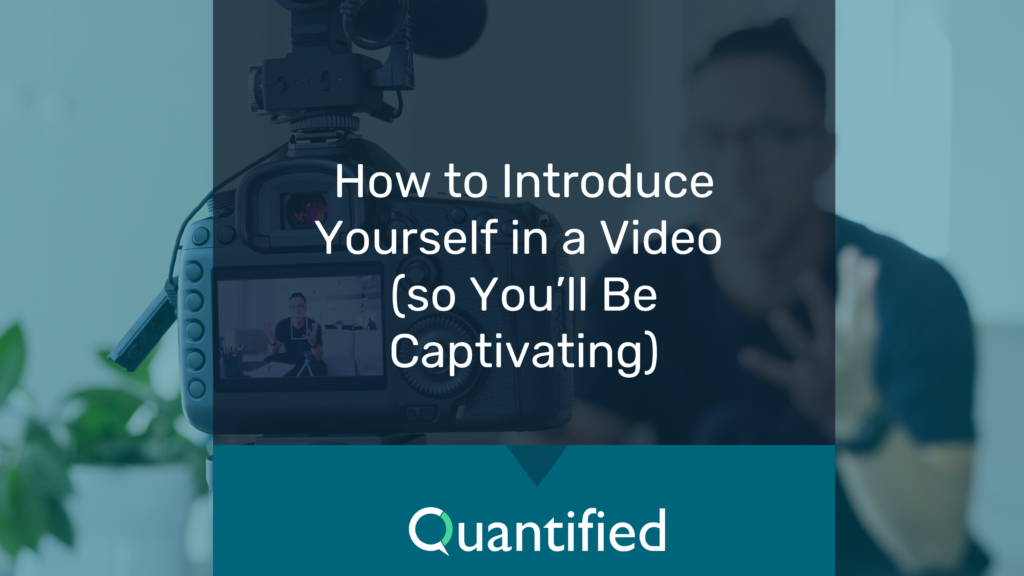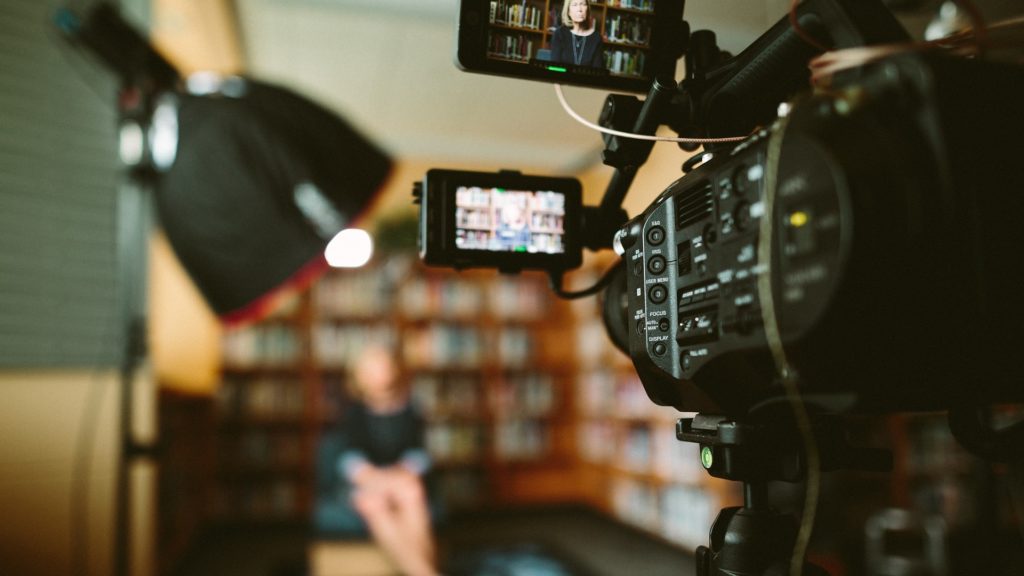How to Introduce Yourself in a Video (so You’ll Be Captivating)

Hi, my name is Noah. I’m the CEO of Quantified Communications, and I’m here to talk to you about—
It doesn’t matter what I’m here to talk to you about, does it, because if I started my video that way, you probably lost interest before I got to the end of my first sentence.
We’ve been thinking and writing a lot lately about how to build strong connections when you don’t have a lot of time. Of course, while strengthening and maintaining these relationships requires long-term work, that first impression is key to a strong initial connection. After all, research has found that, in most communication situations, speakers only have fifteen seconds to make a good first impression with audiences. And 99 percent of the time, your introduction is your first impression. In a recent Ideas article, TED offered eight suggestions for making that first impression memorable and positive). These tips are great for real-time, face-to-face scenarios, and the article is worth a close read, but we wondered what they could teach us about introducing ourselves on a medium that’s become nearly as common as face-to-face interaction: video.
With the rising popularity of “talking head” videos—from YouTube tutorials to Facebook live to Periscope—we’re seeing more and more people pop up on our screens to try to influence our thinking and behavior simply by talking to us.
So how are these people catching our attention? What are they doing that makes us stop scrolling through our newsfeeds and listen to what they have to say?
The cardinal rule, says Quantified communication expert Dr. Kristin Eskind, is not to start just by saying your name. Instead, she recommends capturing the audience’s attention by starting with an interesting story, statistic, or fact, just like you would in an in-person speaking engagement.
Keeping this advice in mind, we sifted through YouTube and Facebook Live to see how some of the top personalities were handling their own introductions. Combining those observations with our research-backed communication best practices, we’ve created a guide to making a great first impression on video.
3 Ways to Capture the Audience’s Attention Right Off the Bat

1. Start with a Story—Not Your Name and Title
There are countless YouTube influencers out there, creating everything from video game reviews to makeup tutorials to character sketches to stream of conscious chats about their own lives. With millions of followers and billions of views, these personalities don’t need to introduce themselves. Instead, they dive right into the content of their videos.
While you may not have 20 million subscribers like Jenna Marbles or Ryan Higa do (yet), but that doesn’t mean you can’t take a page from their books. Instead of starting with a bland introduction that will have viewers clicking to the next video, take Dr. Eskind’s advice and start with a hook that will grab viewers’ attention and suck them in.
Specifically, we recommend starting with a story.
One oft-cited statistic show that messages delivered as stories can be up to 22 times more memorable than straight facts, and that’s largely because stories engage our audiences’ emotions, helping them focus on and later recall what they’re hearing. These emotional appeals are also proven to make a speaker more influential, especially with unfamiliar audiences.
Once you’ve hooked your audience with a compelling story, then you can take a moment to build credibility by letting them know who you are and why they should keep listening.
2. Personify the Camera
One of the main goals of a Facebook Live session or a YouTube video is to build trust with your audience by putting a face with your name. The idea is that, by watching you on screen, audiences feel like they’ve had a real interaction with you and like they know you personally.
But in order to really make these videos work as a trust-building tool, you haveto be authentic. Polished and professional, yes, but not overly rehearsed or performative. One communication expert put it this way in a recent article for Entrepreneur:
Think about it: Viewers are typically about five inches from their phones, and the presenter is within a foot of the screen on the other end. It’s like having a cup of coffee and a chat—it conveys the same sense of friendship, honesty and trust.
You can read more about authentic communication here, but it comes down to this: Today’s audiences can spot a spin doctor from miles away, but if they feel like they’ve gotten to know the real you, they’re more likely to buy into your message. So when you’re communicating with audiences on video, be your honest, transparent self, and speak as though you’re talking with them and not at them.
This kind of authenticity—creating the feeling that you’re talking with your audience—is especially difficult when you’re talking to a camera. After all, talking to inanimate objects is, by nature, more than a little awkward. To make it easier to communicate authentically on video, we recommend treating the camera like a person or, even better, putting an actual person behind the camera. Asking a friend or colleague to sit behind the camera and act as your “dummy” audience—at least until you get more comfortable presenting on video—is a great way to make it easier to be authentic.
3. Make it About Your Audience.
Even though authenticity is essential to video communication, and the apparent spontaneity adds to the charm, preparation is still essential. After all, people aren’t interested in hearing you ramble about yourself—they care about what you can do for them.
What that means is that you not only need to prepare your presentation ahead of time, but you need to prepare it with your audience in mind.While, when it comes to live presentations, we recommend one hour of prep and rehearsal for every minute you’ll be speaking, the requirements can be a little looser for most informal video presentations. But before you hit record, you need to have a sense for what’s on the mind of your audience. So when you’re preparing what you have to say, consider how to make sure your message resonates. (Learn more about audience-first communication in our recent blog post.)
In general, failure to prepare is likely to lead to an unfocused, rambling, difficult-to-follow video that won’t do you or your audiences any good, and may even hurt your brand and reputation. But with a little thought before you get in front of the camera, you can feel confident that you’re going in with a game plan, and you’ll be able to guide your audiences along so they can more clearly follow and internalize your message.
Remember, when you get right down to it, a personal video—on YouTube, Facebook, or even your company’s website—is a tool for helping your audience get to know you better. With a little preparation, a good hook, and a focus on coming across as your authentic self, you’ll be set to record a great video.
Here’s a quick warm-up video to help you prepare for your own video from Blended Sense:
Navigating Video Calls: Strong Presence and Overcoming Zoom Fatigue
In today’s predominantly virtual world, video calls have become the norm, and while they offer convenience, they also come with unique challenges—namely, maintaining a strong video presence and dealing with the phenomenon known as Zoom fatigue.
Here are some tips to ensure your virtual meetings are effective and engaging:
- Bring a Strong Video Presence On-Screen
- Lighting and Framing: Ensure your face is well-lit and framed properly within the screen. Natural light is best, but if that’s not available, use a soft, diffused light source. Position your camera at eye level to create a more natural and engaging connection with your audience.
- Eye Contact: It’s easy to get distracted by looking at your own image or that of others during a video call. However, maintaining eye contact by looking directly into the camera when speaking can create a stronger connection with your audience, much like in-person interactions.
- Clear and Concise Communication: Given the limitations of virtual communication, it’s more important than ever to be clear and concise. Avoid rambling and stick to key points that convey your message effectively.
- Tips for Overcoming Zoom Fatigue
- Take Regular Breaks: Continuous video meetings can be exhausting. Schedule short breaks between meetings to rest your eyes, stretch, and reset your mind.
- Set Boundaries: Not all meetings need to be on video. Where appropriate, suggest phone calls or asynchronous communication methods like email to reduce screen time.
- Optimize Your Environment: Create a comfortable workspace with an ergonomic setup. Reducing physical discomfort can help mitigate the fatigue associated with long hours in virtual meetings.
- Mind Your Energy Levels: Pay attention to your energy levels throughout the day and schedule your most demanding video meetings during your peak productivity times.
By incorporating these strategies, you can enhance your video presence, making your virtual interactions more engaging and impactful while also taking care of your well-being.
Looking to strengthen your video calls with prospects? Check out this content here: 10 Ways to Have Better Video Calls with Prospects Every Time.
With these tips, you’ll be well-equipped to navigate the challenges of video communication, whether you’re recording a YouTube video or conducting a series of Zoom meetings. Remember, it’s about creating meaningful connections, no matter the medium.